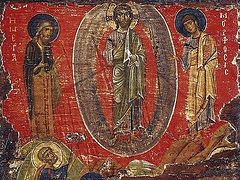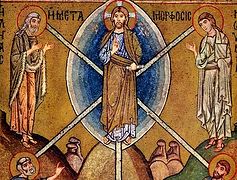“We are both in the Spirit of God now, my son. Why have you cast your gaze downward? Why don’t you look at me?” I replied: “I can’t look, Father, because your eyes are flashing like lightning. Your face has become brighter than the sun, and my eyes ache with pain.” Fr. Seraphim said: “Don’t be alarmed, your godliness! Now you yourself have become as bright as I am.” And bowing his head towards me, he quietly said in my ear: “Thank the Lord God for His ineffable mercy to you!” (Conversation of St. Seraphim of Sarov with Motovilov on the purpose of the Christian life)
 Conversation of St. Seraphim and Motovilov
Conversation of St. Seraphim and Motovilov
The disciples contemplated the transfigured Christ as if in a vision. When they recovered, they again found a man before them—the teacher and guide Jesus, Who was always there, and Whom they always followed. He told the Apostles: Tell the vision to no man, until the Son of Man be risen again from the dead (Mt. 17:9). Jesus commanded to keep in their hearts the secret of the vision, which came from the depths of the heart. In other words, the Transfiguration doesn’t reach human nature: Man is unable to sense it, neither with the mind nor the senses nor the body. The Divine glory has a different nature. There’s nothing like it in the created world.
The white clothing and the sun-like radiance described in the Transfiguration are an image of how the Divine is perceived. We represent it with symbols: The church is filled with icons and the interior is decorated with fabrics and flowers—everything has a material image—form and color. But the Divinity revealed to the disciples had no image: no color, no smell, no radiance, no darkness—nothing, because it was a Divine manifestation. Man can only perceive it deep within.
We have within us the beginning of the Divine—the ability to recognize the uncreated God, sensing His presence in our lives and trusting the stories of other people about it. Man is also able to recognize God’s “right hand” in the beauty and purposefulness of surrounding nature.
You can glorify God not so much with the creation of your own hands—with the beautiful interior of churches, icons, and vestments—as with an inner spiritual response, feeling God’s presence where His voice is heard.
Why was the Apostle Peter, not following other people’s stories and beliefs, himself a witness of the Divine phenomenon and a partaker of His uncreated glory—the nature of Divine majesty (cf. 2 Pt. 1:16)? How can a man know God’s glory? Peter saw the Divine in Christ and felt in himself a co-presence with Him. We are created according to the image of God precisely because we resemble Christ, at least outwardly…
Man is given the ability to recognize the Divine. Why do we go to church? Not just to talk with people, but also for solitude. Holy ascetics and hermits spent many decades in deserts, praying and abiding in the joy of communion despite the external solitude. They learned to recognize the Divine in themselves, as it was revealed in Christ. It’s not man himself, but God Who develops this ability. Gradually absorbing the man who is faithful to Him, Christ makes him a partaker of the uncreated Divine nature through His Body and Blood. Christ showed the Transfiguration to His disciples, and now the Church manifests this Divine ability. The Sacraments of the Church can’t exist without touching the mystery of God and the Transfiguration of Christ.
 Having awakened as though from a dream, the disciples see the man they’ve always been with; no white clothes, radiance, or the cloud symbolically indicating the presence of God’s Spirit. The voice of the Father isn’t heard: This is My beloved Son, in whom I am well pleased (Mt. 17:5). Before the disciples again stands a man, but everything has changed in them. Jesus is the God-Man, as the vision they beheld reminds them. Having come into contact with the Divinity of Christ, the ability to recognize the Divine was revealed in them. It’s impossible to tell others about it, just as it’s impossible to convey faith to others by “forcing” them to believe.
Having awakened as though from a dream, the disciples see the man they’ve always been with; no white clothes, radiance, or the cloud symbolically indicating the presence of God’s Spirit. The voice of the Father isn’t heard: This is My beloved Son, in whom I am well pleased (Mt. 17:5). Before the disciples again stands a man, but everything has changed in them. Jesus is the God-Man, as the vision they beheld reminds them. Having come into contact with the Divinity of Christ, the ability to recognize the Divine was revealed in them. It’s impossible to tell others about it, just as it’s impossible to convey faith to others by “forcing” them to believe.
When God mysteriously touches a man’s heart and mystically leads him along, then people are near each other and represent a community, a parish and church, sharing the mystery of Divine communion together. It’s impossible to force this, but through inner effort, the exercise of fasting and prayer, we gradually come to meet the Living God. We are co-transfigured in Christ when God Himself reveals Himself as He is. Immeasurably higher than all existence and all creation, it’s impossible to see and recognize Him any other way.
Having founded the Church for the succession of faith by His Resurrection from the dead, Christ “supplied” man with the ultimate hope and confidence. Growing up, everyone begins to ponder, “Why am I alive and where am I going? What happens when I take my last breath?” And Christ assures us, “I will meet and receive you, only don’t depart from the faith, even while it cannot be proven or disproven.”
The threshold of life and death doesn’t interrupt the encounter with Christ: If we met Him in this life, then we can easily recognize Him anywhere. If there was no experience of meeting Him, then the transition will be a test, and only God knows whether a man will pass or not. His Judgment is final, and therefore it’s called “Dread.” Guided by the hand of the transfigured Christ, we can enter into His resurrection through His Transfiguration—in Christ’s Sacraments, we can experience the Transfiguration and taste of the Resurrection together with the Apostles. While a man can’t reliably tell another about it, his heart has already accepted everything, rejoiced, and felt a sense of calm.



